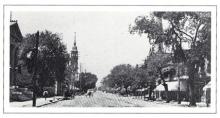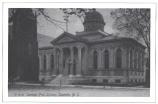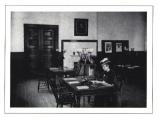You are here
Chapter 2
By February, another plan was taking shape. Thomas S. Franklin, secretary for a Charlotte cotton press manufacturer and a member of the city board of aldermen, heard that industrialist Andrew Carnegie was offering cities and towns money for library construction. On his next business trip to New York, Franklin called on personal friend James Bertram, then secretary of the Carnegie Corp. With his help, arrangements were made for Charlotte to receive a gift of $20,000, later increased to $25,000.
The gift required the city to furnish a site and taxes of at least $2,500 per year for operations. Carnegie attributed his own success in life to his early access to books and learning. He wrote that, "I believe that (the public library) outranks any other one thing that a community can do to benefit its people. It is the never failing spring in the desert." Charlotte citizens approved the tax May 6, 1901, and construction began soon after.
The library directors selected a site near the corner of 6th and Tryon Streets where the library has remained to this day. It was occupied by homes in 1901. But the block had already begun to feel the encroachment of the central business district. Toward the Square were a variety of shops and offices to the north, neighborhood grocery stores and the First Baptist Church. In both directions, large oaks shaded Tryon Street and the carriages and streetcars which traveled along it.
The new building had the typical Carnegie look. Outside was an imposing classic facade with four Ionic columns. Inside, dark oak furniture and paneling set a somber mood. The interior was divided into a reading room, a book room, a children's room and an office. There was also a room containing historical materials and memorabilia and a basement. In his dedication address on July 2, 1903, Thomas Franklin pronounced it an "influence for good" in the community.
Despite a meager collection of only 2,526 volumes, librarian Annie Smith Ross and her assistant launched an ambitious program of activities. The library became a center for educational and cultural events, including lectures, children's book programs and benefit concerts. Bird Day at the library in April 1904 attracted 500 to 600 children and adults, according to newspaper accounts.
A regular column, "Library Notes" appeared in the local newspaper announcing library events and commenting on the tastes of the reading public. In 1904, one column noted that "the most popular light literature of to-day is that which deals with life of the every-day, simple sort, told in a simple, homely way, and containing a sprinkling humor and action". By the end of the library's first six months 1,480 of Charlotte's 18,000 citizens had registered to use the library.
Ryckman, Patricia. Public Library of Charlotte & Mecklenburg County: A Century of Service. Charlotte, N.C.: Public Library of Charlotte and Mecklenburg County, 1989.


